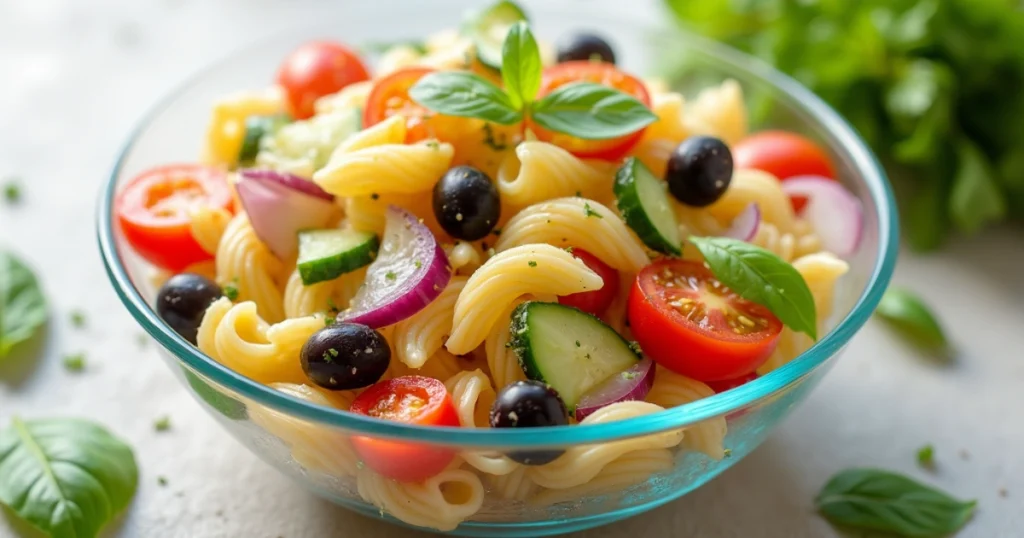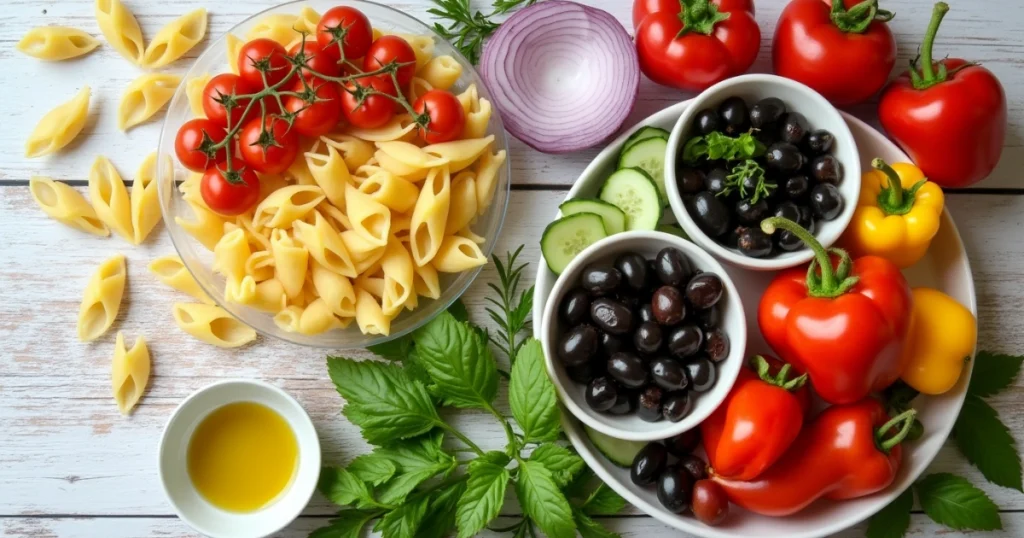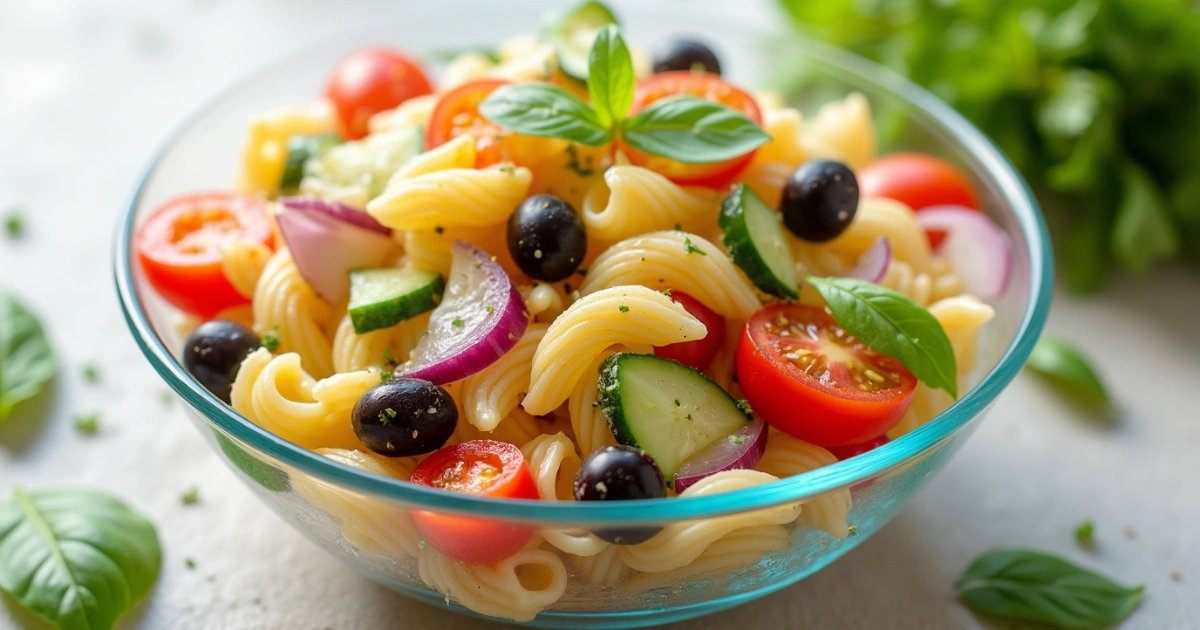
Table of Contents
Pasta Salad: A Colorful and Refreshing Dish for Every Occasion
Pasta Salad is a versatile, chilled dish made with cooked pasta, fresh vegetables, and a variety of flavorful ingredients, all tossed together in a dressing. This easy-to-make dish is perfect for picnics, barbecues, or as a side dish for family dinners. The refreshing, tangy flavors combine with the heartiness of pasta to create a satisfying and light meal. With endless variations, pasta salad can be customized to fit any dietary preference, making it a go-to recipe for anyone looking to prepare a crowd-pleasing dish.
Origin and Taste
Pasta salad is believed to have originated in Italy, where cold pasta dishes are often served as part of a larger meal. It became especially popular in the United States in the 20th century as a picnic staple and barbecue favorite. The taste is a delightful combination of tangy, creamy, or vinaigrette-based dressing paired with the textures of al dente pasta, crisp vegetables, and other added ingredients like cheese or meats. Its versatility allows for endless flavor combinations, whether you prefer a creamy or vinaigrette dressing, making it both a refreshing and indulgent dish.
Why This Article?
This article aims to provide helpful, high-quality content to anyone interested in learning how to prepare a delicious pasta salad. Whether you’re new to cooking or an experienced chef looking to discover new ways to create a fresh, flavorful dish, this guide will give you all the information you need to make the perfect pasta salad every time. From ingredient suggestions to step-by-step instructions, we’ll cover everything you need to know, making it easier than ever to prepare this crowd-pleasing dish.
1. List of Ingredients

- Pasta (1 ½ cups dry) – Choose from various types of pasta like fusilli, rotini, penne, or elbow macaroni.
- Cucumber (1, diced) – Adds freshness and crunch.
- Cherry tomatoes (1 cup, halved) – For sweetness and color.
- Red onion (¼ cup, finely chopped) – Adds sharpness and flavor.
- Bell pepper (1, diced) – Adds sweetness and color.
- Olives (½ cup, pitted and sliced) – Adds briny flavor.
- Cheese (½ cup, cubed or shredded) – Cheddar, mozzarella, or feta cheese.
- Cooked chicken (optional, 1 cup, diced) – Adds protein (optional for a heartier salad).
- Dressing:
- Olive oil (2 tbsp)
- Red wine vinegar (1 tbsp)
- Dijon mustard (1 tsp)
- Garlic powder (¼ tsp)
- Salt and pepper (to taste)
Substitutes
- You can use gluten-free pasta or whole wheat pasta for a healthier or gluten-free version.
- Swap the vegetables based on personal preferences (e.g., add shredded carrots, or use peas instead of cucumbers).
- For a dairy-free version, omit cheese or use a dairy-free substitute.
2. Servings
This recipe serves 4-6 people, depending on portion size.
3. Preparation Time
- Active Time: 15 minutes
- Inactive Time: 1 hour (for chilling the salad in the fridge)
- Total Time: 1 hour 15 minutes
4. Cooking Time
- Cooking Time: 8-10 minutes (to cook the pasta)
- Cooking Temperature: N/A (no need for heat once the pasta is cooked)
- Cooking Method: Boil the pasta, then chill.
5. Step-by-Step Instructions
- Cook the pasta: Bring a large pot of salted water to a boil. Add the pasta and cook according to package instructions until al dente, about 8-10 minutes. Drain the pasta and rinse under cold water to cool it down.
- Prepare the vegetables: While the pasta is cooking, dice the cucumber, halve the cherry tomatoes, chop the red onion, and dice the bell pepper. If using cooked chicken, cut it into small cubes.
- Make the dressing: In a small bowl, whisk together olive oil, red wine vinegar, Dijon mustard, garlic powder, salt, and pepper until well combined.
- Combine the salad: In a large bowl, add the cooled pasta, vegetables, olives, cheese, and optional chicken. Pour the dressing over the top and toss everything together until evenly coated.
- Chill and serve: Cover the bowl with plastic wrap and refrigerate the pasta salad for at least 1 hour before serving. This allows the flavors to meld together.
6. Difficulty Level
This pasta salad is easy to make, requiring only basic cooking and chopping skills. It is perfect for beginners but can be easily customized by more experienced cooks.
7. Presentation and Plating Suggestions
- Serve the pasta salad in a large serving bowl, garnished with extra chopped herbs like parsley or basil for a fresh look.
- For a more formal presentation, serve individual portions in small bowls with a sprinkle of cheese or extra dressing on top.
- You can also add a side of crusty bread or grilled meat for a complete meal.
8. Taste Profile
The taste of pasta salad is a blend of:
- Tangy: The dressing (especially if using vinaigrette) adds a tangy, refreshing note.
- Savory: The cheese and olives provide savory, briny flavors.
- Fresh: The vegetables bring a crisp, fresh element to balance the richness of the dressing and cheese.
- Herbaceous: If fresh herbs are used, they add aromatic depth to the salad.
9. Allergen Information or Dietary Restrictions
- Contains: Dairy (cheese, depending on type used), gluten (pasta).
- Substitute Options: Use gluten-free pasta for those with gluten sensitivities, and dairy-free cheese for a dairy-free option.
- Vegetarian-Friendly: Yes, unless you add chicken or other meats.
- Nut-Free: Yes, unless you add nuts such as almonds or pine nuts.
10. Nutritional Information
(Per Serving)
- Calories: 280 kcal
- Protein: 10g
- Carbohydrates: 30g
- Fat: 15g
- Fiber: 3g
- Sodium: 420mg
- Cholesterol: 15mg
Nutritional values may vary based on the ingredients used and portion sizes.
11. Storage and Leftover Tips
- Storage: Store pasta salad in an airtight container in the fridge for up to 3 days.
- Reheating: Pasta salad is typically served chilled, so there is no need to reheat it. However, if you prefer it warm, you can let it sit at room temperature for a few minutes before serving.
- Adjusting Consistency: If the pasta salad seems dry after storage, add a little more dressing to revive its flavor.
12. Troubleshooting
- Too dry? Add more dressing, a splash of olive oil, or a little lemon juice to moisten the salad.
- Overwhelming vinegar taste? If the vinegar is too strong, balance it with a teaspoon of sugar or honey to mellow the acidity.
- Not enough flavor? Add more salt, pepper, or herbs to enhance the taste.
13. Cultural or Historical Context
Pasta salad is a dish that gained popularity in the United States in the mid-20th century, particularly in the 1950s and 1960s, when convenience foods and cold salads were in high demand for picnics, potlucks, and summer gatherings. It became a symbol of quick, easy, and customizable dishes for families and large groups. While the dish has many regional variations, its simple, adaptable nature means that it is now enjoyed around the world in numerous forms. In Italy, cold pasta dishes are often served as part of a larger meal, though pasta salad as we know it today is more of an American creation.

